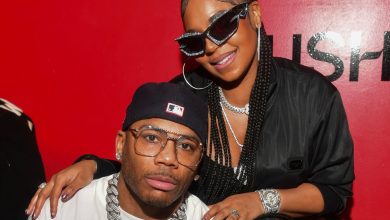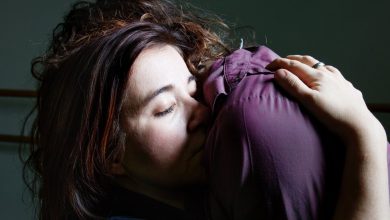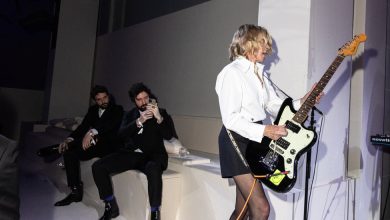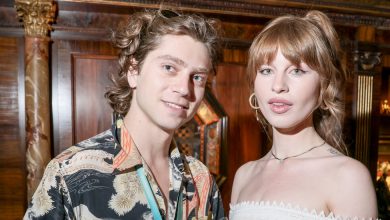Michelle Obama’s Fashion Declaration of Independence
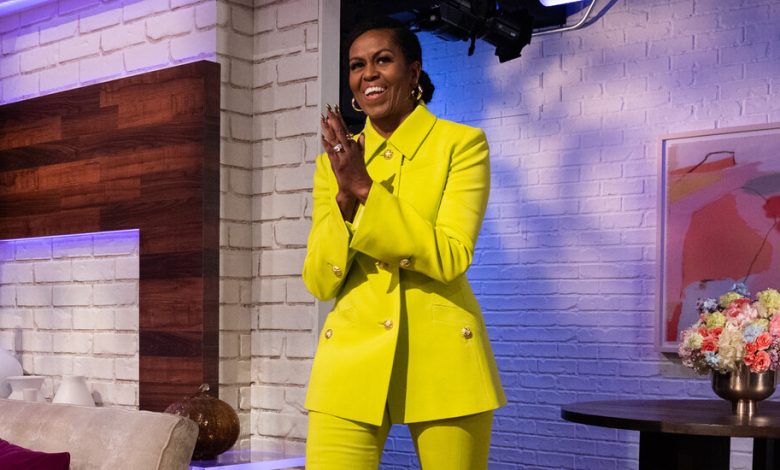
When is a book tour not just a book tour? When it is a platform for the refashioning, literally, of a major public figure — when it is a way for someone whose image at one stage of her life has been memorialized for posterity to signal that it is time to move on.
That she, for one, already has.
So it seems in the case of Michelle Obama, at least judging by the image-making on view during her sea-to-shining sea promotional junket for “The Light We Carry,” which came to a close this week. That something new was going on (and not just a new book) was obvious not just to those who made it to a theater to listen to her discuss her memoir/self-help tome with such figures as Gayle King, Conan O’Brien, Ellen DeGeneres and Tyler Perry, but to anyone following along on social media.
The first lady — the one preserved in oils by the painter Sharon Sprung wearing a sky blue off-the-shoulder evening gown, her shoulder-length hair styled in soft, straight wings around her face — has been left framed on the White House wall. Instead, Mrs. Obama has, in multiple public outings, traded her floral dresses, corporate sheaths and J. Crew cardigans for edgy trouser suits, T-shirts and braids, as if declaring independence from the constraints and conventions heaped on her when she was in the Executive Mansion. There was a lot of flair happening. And flares.
The transformation began in New York City, with the highlighter-yellow Proenza Schouler pantsuit she wore for an appearance on the “Today” show. Picked up steam with the flowing black-and-magenta Versace zebra print shirtdress over fuchsia cargos she wore in Washington, D.C. Served notice that something new was happening with head-to-toe Ganni denim in Philadelphia. Reached peak fly girl nostalgia with a multicolor Roksanda x Fila zip-up sweatshirt, what looked like a one-shoulder periwinkle blue bodysuit and baggy black pants in Atlanta.



Mrs. Obama making a fashion statement in (from left) Versace zebra stripes, Ganni denim and a Roksanda x Fila warm-up jacket and Christy Rilling top.Credit…Meredith Koop (left and right); Tasos Katopodis/Getty Images (center)
Caused a kerfuffle with a Brandon Maxwell zip-up bustier and matching cargo pants worn over a long-sleeve white T-shirt, and a velvet Balmain trouser suit paired with a customized Diana Ross T-shirt in San Francisco (a clever wink at Ms. Ross’s daughter, Tracee Ellis Ross, who was doing the interviewing).
And culminated in oversize faded Balmain jeans worn with a Marine Serre black top with a print silk scarf draped across the bust.
Oh, and there were some Palmer Harding eco-leathers and a Stella McCartney jumpsuit in there, too.
As with the book itself, which mixes homey anecdotes with advice on how to handle anxiety, pressure and self-doubt, the clothes seem personal; the wardrobe of someone who has shrugged off the filters and decided to dress for herself as opposed to dressing to please (or maybe just not to upset) the largest possible constituency. Like the fits or not, there’s no denying that Mrs. Obama seemed to be having fun with what she was wearing. She was modeling a different kind of choice, one that prioritized an energetic self-expression over fitting in. Her clothes popped. They were unexpected.
After all, as she wrote in “The Light We Carry,” for eight years she had to remain “careful with my image,” conscious that, as what she called an “only” (the only Black first lady, the only Black first lady lawyer and so on), she was walking a fine line between tradition and the future; between what had come before and what could be. Every choice she made was seen as public property, and that extended to every item she wore and every styling decision she made.



More agenda-setting in (from left) Brandon Maxwell, Palmer Harding leathers and Balmain velvet, with another custom Christy Rilling top.Credit…Meredith Koop (left and right); Derek White/Getty Images (center)
As she told Ellen DeGeneres in their conversation on the tour, she considered wearing her hair in braids while in the White House — it would have been easier — but she chose not to because she didn’t think the American people were ready for Black hair. It was enough that they were getting adjusted to a Black president and a Black first family. She decided, she said, to “keep my hair straight.” Better to keep the conversation focused on health care.
Even after the Obamas left the White House, when Mrs. Obama published her best-selling “Becoming” and embarked on her first book tour, her image seemed to bridge the role she had played and the direction in which she was going. Her choices were getting more sparkly and adventurous (remember those thigh-high iridescent Balenciaga stiletto boots?) while at the same time remaining recognizably tailored.
Now, almost four years later, it’s a different story. One that, the stylist Meredith Koop told Vogue, was largely about “wanting to be more and more comfortable.” (She declined to add any more.) You can’t really argue with that. Comfort is the one trend everyone can agree on, following pandemic lockdowns.
Yet given how strategic Mrs. Obama was about her wardrobe choices during her husband’s administration; given how she used the spotlight to focus attention on a host of independent names representative of the American melting pot; given how aware she has been that her every look is followed (her superwoman burgundy trousers-’n’-belt outfit at the Biden inauguration practically caused an internet meltdown), it’s impossible not to think that the current shift is about more than just physical comfort. It’s also about the comfort of being at ease with your own self. And in that, it is a deliberate statement of intent. Of freedom.
Mrs. Obama is setting her own rules, defining herself according to her own expectations, as opposed to the expectations of the role she has to fill. Who wears the pants?
At this point, she does.
